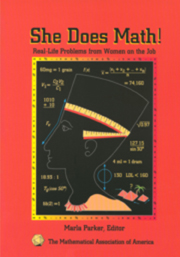Book contents
- Frontmatter
- Preface
- Contents
- Problems by Subject
- Environmental Psychology
- Software Engineering; Computer Science
- Archaeology
- Mathematics and Computer Science
- Civil Engineering
- Mathematics
- Electrical Engineering
- Physics; X-ray Astronomy Research
- Mathematics
- Physics; Astronaut Crew Training Instructor
- Business Data Processing
- Software Engineering; Real Estate Investment
- Quality Engineering
- Health Science
- Nursing Education
- Electrical Engineering; Space Systems
- Oil and Gas Accounting
- Business Administration Higher Education
- Aerospace Engineering
- Structural Engineering
- Computer Science
- Mathematics
- Dietetics—Foodservice Management and Nutrition
- Electrical Engineering
- Chemical Engineering, retired
- Software Engineering
- Immunology and Microbiology
- Mechanical Engineering
- HMO Pharmacy Practice and Management
- Ophthalmology
- Electrical Engineering
- Fish Pathology
- Computer Science and Computer Graphics
- Mathematics and Computing
- Electrical Engineering
- Astronomy
- Author
- Mathematics
- Reflections on WAM
- Solutions
Mathematics
- Frontmatter
- Preface
- Contents
- Problems by Subject
- Environmental Psychology
- Software Engineering; Computer Science
- Archaeology
- Mathematics and Computer Science
- Civil Engineering
- Mathematics
- Electrical Engineering
- Physics; X-ray Astronomy Research
- Mathematics
- Physics; Astronaut Crew Training Instructor
- Business Data Processing
- Software Engineering; Real Estate Investment
- Quality Engineering
- Health Science
- Nursing Education
- Electrical Engineering; Space Systems
- Oil and Gas Accounting
- Business Administration Higher Education
- Aerospace Engineering
- Structural Engineering
- Computer Science
- Mathematics
- Dietetics—Foodservice Management and Nutrition
- Electrical Engineering
- Chemical Engineering, retired
- Software Engineering
- Immunology and Microbiology
- Mechanical Engineering
- HMO Pharmacy Practice and Management
- Ophthalmology
- Electrical Engineering
- Fish Pathology
- Computer Science and Computer Graphics
- Mathematics and Computing
- Electrical Engineering
- Astronomy
- Author
- Mathematics
- Reflections on WAM
- Solutions
Summary
I didn't know I liked math until I took the Kuder Personal Preference Test and a course in algebra. A typical question in the Kuder Test is: would you rather grow a flower, sell a flower, or develop a new breed of flower? The test told me that my interest in computation was at the 96th percentile. Discovery of my interest in math (according to the test) surprised me because I had thought that math was boring and also because no one else in my family was interested in math or science. Then I discovered algebra. It gave me a powerful tool to solve the kinds of puzzles I enjoyed doing anyway, so I was convinced that math could really be interesting and useful.
I took algebra in the 9th grade, geometry in the 10th, algebra II in the 11th, and two math courses in the first semester of my senior year—trigonometry and solid geometry—and calculus the second semester (a rigorous, epsilon-and-delta course!). I always got A's in math. The only sciences I took were chemistry and physics. I was nervous about taking physics, because I thought it was a “boy's subject,” but my counselor convinced me to try it and I became the best student in the class. I also took two semesters of drafting in high school, one of them in summer school; that remains one of my proudest accomplishments, since I went from F's on all my early work up through D's, C's, B's, and finally A's.
- Type
- Chapter
- Information
- She Does Math!Real-Life Problems from Women on the Job, pp. 156 - 160Publisher: Mathematical Association of AmericaPrint publication year: 1995



